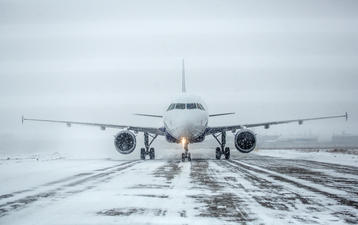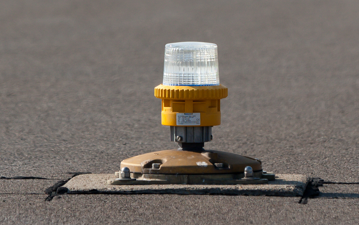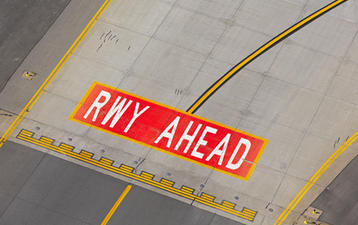Global Reporting Format (GRF) and Runway Surface Condition Assessment
Adverse runway surface conditions, notably contamination with standing water, snow, slush or ice, play a major role in a lot of safety events at aerodromes. A contributing factor is the non-standardized way of runway surface condition assessment and reporting, leaving pilots without reliable information to carry out their performance calculations.
For this reason, ICAO has implemented a package of amendments for a new Global Reporting Format (GRF) for Runway Surface Conditions, effective since November 2021, involving several ICAO Annexes, Manuals and the PANS-Aerodromes. The changes are mainly based on the FAA initiative to implement a standardized format for assessing and reporting runway surface conditions, called TALPA (Takeoff and Landing Performance Assessment).
EASA has introduced these changes in Regulation (EU) 2020/2148 applicable from 12th of August 2021, amending Regulation (EU) No 139/2014 and associated AMCs and GMs and CS-ADR-DSN.
Airport operators are faced with the challenge to understand and implement the new rules, particularly the shift from a mainly friction measurement based runway evaluation towards a broader assessment of runway condition to issue a Runway Condition Report (RCR). Procedures and technical equipment must meet the needs for the timely provision of runway state information.
During this 2-day course participants will become familiar with the new Runway Condition Matrix (RCAM) and Code (RWYCC) and the Global Reporting Format (GRF) and will learn how to assess adequately the runway condition and how to prepare the Runway Condition Report. The participants from aerodrome safety and operations departments will learn from pilot’s perspective, what is relevant for flight crew and what is the impact on aircraft performance. Operative personnel, Safety and Operations Managers as well as pilots will gain an understanding of the changes, learn how to use the new format and profit from a cross-stakeholder exchange of experience.
Course Details
Location:In-houseLanguage:German / English
Duration:2 days
Provider:airsight GmbH
Course Content
Background for implementation of a standard format
- Common practices for assessing and reporting runway conditions
- Regulatory framework
- Regulation (EU) 2020/2148 amending Regulation (EU) No 139/2014
- AMC and GM to Authority, Organisation and Operations Requirements for Aerodromes - Issue 1, Amendment 5 (Executive Director Decision 2021/003/R)
- Issue 5 of CS-ADR-DSN (Executive Director Decision 2021/004/R)
- ICAO Circular 355 - Assessment, Measurement and Reporting of Runway Surface Conditions
- Overview TALPA, CRFI (Canada), GRF, EASA
- Identification of changes
- Limitations of runway condition assessment
Runway condition assessment
- Types of contaminants
- Runway friction tests
- Assessment principles
- Common procedures to conduct runway assessments, when, how, who?
- Sensor systems, mobile systems, runway sensors, on-board systems (BACF, NAVBLUE)
Runway Condition Assessment Matrix (RCAM)
- Define the elements of the RCAM
- Runway Condition Code (RwyCC)
- Rules for upgrading and downgrading RwyCC
Reporting
- SNOWTAM
- Global Reporting Format (GRF), RwyCC
- Generation of reports
Pilot session
- Threats associated with runway contamination for Flight Operations
- Challenges for pilots
- Explanation of changes and benefits of TALPA/RCAM
- Worked examples of TALPA/RCAM handling
- Case studies of overrun events and lessons learnt
Examples and exercises on reporting and assessing
Trainer
Mark Taylor
Mark is an Airbus A320 Captain for a major flag carrier Airline, with 11,000 flying hours and 15 years experience working in Aviation. During this time, he has held positions in Flight safety, taking responsibility for embedding Safety Management Systems (SMS) as well as completing Flight operations safety audits and risk assessments to ensure compliance. Also, Mark has taken responsibility for delivering mitigation strategies to manage risk.
Mark's key area of expertise is Human Factors where he has written and delivered numerous courses to support Aviation and Healthcare with developing and monitoring a 'no blame culture.' An extensive knowledge of Flight operations and Safety Management, coupled with front line flying experience enables Mark to offer innovative, efficient and highly effective solutions.
Target Group
- Aerodrome safety managers
- Aerodrome safety deputies / safety team members
- Aerodrome operations managers and duty officers
- Civil Aviation Authorities staff
- Air Traffic Control staff
- Pilots
Organisational Details
airsight offers this training course on request, worldwide. At the end of the course, all participants will receive an airsight certificate based on EASA training regulations, which is highly recognised throughout the aviation industry.
About airsight Training
airsight Training course quality
airsight operates an ISO 9001 certified Quality Management System and pursues the objective to provide high quality services that fully meet the clients’ needs.


 Training 5 or more people? Ask for an In-house course at your premises or online!
Training 5 or more people? Ask for an In-house course at your premises or online!


